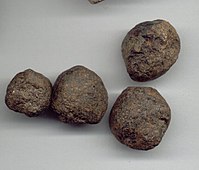Limonite
| Limonite | ||
|---|---|---|
Specific gravity 2.9–4.3 | | |
| Density | 2.7–4.3 g/cm3 | |
| References | [1][2][3] | |
Limonite (/ˈlaɪməˌnaɪt/) is an iron ore consisting of a mixture of hydrated iron(III) oxide-hydroxides in varying composition. The generic formula is frequently written as FeO(OH)·nH2O, although this is not entirely accurate as the ratio of oxide to hydroxide can vary quite widely. Limonite is one of the three principal iron ores, the others being hematite and magnetite, and has been mined for the production of iron since at least 400 BC.[4][5]
Names

Limonite is named for the Ancient Greek word λειμών (leimṓn [leː.mɔ̌ːn]), meaning "wet meadow", or λίμνη (límnē [lím.nɛː]), meaning "marshy lake", as an allusion to its occurrence as bog iron ore in meadows and marshes.[6] In its brown form, it is sometimes called brown hematite[7] or brown iron ore.[8]
Characteristics
Limonite is relatively
Although originally defined as a single mineral, limonite is now recognized as a
-
Limonite deposited from mine runoff
-
Galena and limonite
-
Limonite pseudomorphs after garnet
Formation
Limonite usually forms from the hydration of hematite and magnetite, from the oxidation and hydration of iron rich sulfide minerals, and chemical weathering of other iron rich minerals such as olivine, pyroxene, amphibole, and biotite.[10] It is often the major iron component in lateritic soils, and limonite laterite ores are a source of nickel and potentially cobalt and other valuable metals, present as trace elements.[15][16] It is often deposited in run-off streams from mining operations.
Uses
Nickel-rich limonite ores represent the largest reserves of nickel. Such minerals are classified as lateritic nickel ore deposits.[17]
One of the first uses was as a
Bog iron ore and limonite mudstones are mined as a source of iron.Iron caps or
These gossans were used by prospectors as guides to buried ore.Limonite was mined for its ancillary gold content. The oxidation of sulfide deposits which contained gold, often resulted in the concentration of gold in the iron oxide and quartz of the gossans. The gold of the primary veins was concentrated into the limonites of the deeply weathered rocks. In another example the deeply weathered iron formations of Brazil served to concentrate gold with the limonite of the resulting soils.
History
Limonite was one of the earliest materials used as a pigment by humans, and can be seen in Neolithic
While the first iron ore was likely meteoric iron, and hematite was far easier to smelt, in Africa, where the first evidence of iron metallurgy occurs,[dubious ] limonite is the most prevalent iron ore. Before smelting, as the ore was heated and the water driven off, more and more of the limonite was converted to hematite. The ore was then pounded as it was heated above 1250 °C,[22] at which temperature the metallic iron begins sticking together and non-metallic impurities are thrown off as sparks.[dubious ] Complex systems developed, notably in Tanzania, to process limonite.[23] Nonetheless, hematite and magnetite remained the ores of choice when smelting was by bloomeries, and it was only with the development of blast furnaces in the 1st century BCE in China[24] and about 1150 CE in Europe,[25] that the brown iron ore of limonite could be used to best advantage.
Bog iron ore and limonite were mined in the US, but this ended with the development of advanced mining techniques.
Goldbearing limonite gossans were productively mined in the
As saprolite deposits have been exhausted in many mining sites, limonite has become the most prominent source of nickel for use in energy dense batteries.
See also
Notes
- ^ Limonite, Mindat.org, retrieved 2011-10-16
- ^ "Mineral 1.0: Limonite". Retrieved 2011-10-16.
- ^ "Limonite (hydrated iron oxide)". Retrieved 2011-10-16.
- on 11 March 2012
- ^ Diop-Maes, Louise Marie (1996) "La question de l'Âge du fer en Afrique" ("The question of the Iron Age in Africa") Ankh 4/5: pp. 278–303, in French; archived here by Internet Archive on 25 January 2008
- ^ Limonite, Mindat.org
- ISBN 0922152349.
- ^ Jackson 1997, "brown iron ore".
- ^ OCLC 2753195
- ^ ISBN 9780195106916.
- ISBN 047157452X.
- .
- .
- ^ Boswell, P. F. and Blanchard, Roland (1929) "Cellular structure in limonite" Economic Geology 24(8): pp. 791–796
- .
- S2CID 125368631.
- ISBN 978-3527306732.
- ^ Constantinou, G. and Govett, G. J. S. (1972). "Genesis of sulphide deposits, ochre and umber of Cyprus". Transactions of the Institution of Mining and Metallurgy. 81: pp. 34–46
- ^ Heckel, George B. (1910) "Iron Oxide Paints". Paint, oil and drug review. 50(4): pp. 14–21, page 14
- ^ OCLC 5458708
- ^ Wilford, John Noble (13 October 2011) "In African Cave, Signs of an Ancient Paint Factory" The New York Times; hardcopy published 14 October 2011 under title "African Cave, Ancient Paint Factory Pushes Human Symbolic Thought ‘Far Back’" New York edition page A-14; archived by WebCite page 1 and page 2 on 11 March 2012
- ^ Iron oxide becomes metallic iron at roughly 1250°C, almost 300 degrees below iron's melting point of 1538°C.
- ^ Schmidt, Peter and Avery, Donald H. (22 September 1978) "Complex Iron Smelting and Prehistoric Culture in Tanzania" Science201(4361): pp. 1085–1089
- ISBN 978-1-84171-008-2
- on 11 March 2012



